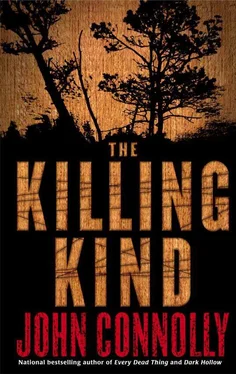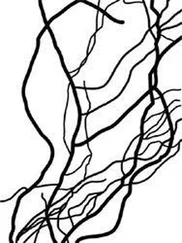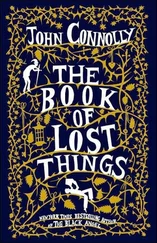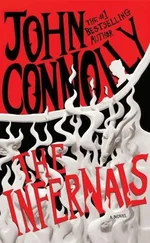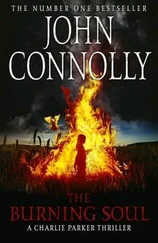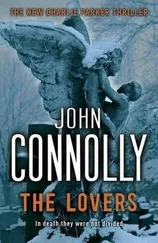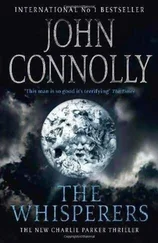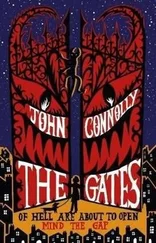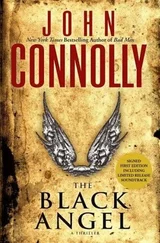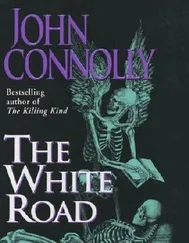
John Connolly
The Killing Kind
The third book in the Charlie Parker series
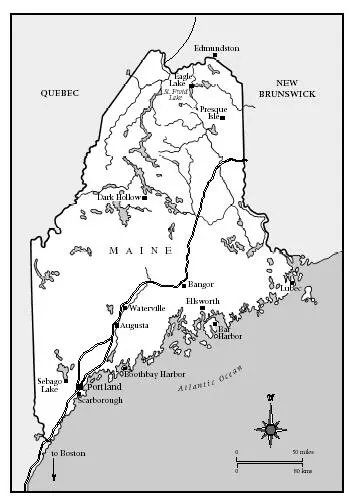
And heavy is the tread
Of the living; but the dead
Returning lightly dance…
– EDWARD THOMAS, “ROADS”
THIS IS A HONEYCOMB WORLD.
It hides a hollow heart. The truth of nature, wrote the philosopher Democritus, lies in deep mines and caves. The stability of what is seen and felt beneath our feet is an illusion, for this life is not as it seems. Below the surface, there are cracks and fissures and pockets of stale, trapped air; stalagmites and helactites and unmapped dark rivers that flow ever downward. It is a place of caverns and stone waterfalls, a labyrinth of crystal tumors and frozen columns where history becomes future, then becomes now.
For in total blackness, time has no meaning.
The present is imperfectly layered on the past; it does not conform flawlessly at every point. Things fall and die and their decay creates new layers, thickening the surface crust and adding another thin membrane to cover what lies beneath, new worlds resting on the remains of the old. Day upon day, year upon year, century upon century, layers are added and the imperfections multiply. The past never truly dies. It is there, waiting, just below the surface of the now. We stumble into it occasionally, all of us, through remembrance and recall. We summon to mind former lovers, lost children, departed parents, the wonder of a single day when we captured, however briefly, the ineffable, fleeting beauty of the world. These are our memories. We hold them close and call them ours, and we can find them when we need them.
But sometimes that choice is made for us: a piece of the present simply falls away, and the past is exposed like old bone. Afterward, nothing can ever be the same again, and we are forced to reassess the form of what we believed to be true in the light of new revelations about its substance. The truth is revealed by a misstep and the fleeting sense that something beneath our feet rings false. The past bubbles out like molten lava, and lives turn to ash in its path.
This is a honeycomb world. Our actions echo through its depths.
Down here, dark life exists: microbes and bacteria that draw their energy from chemicals and natural radioactivity, older than the first plant cells that brought color to the world above. Every deep pool is alive with them, every mine shaft, every ice core. They live and die unseen.
But there are other organisms, other beings: creatures that know only hunger, entities that exist purely to hunt and kill. They move ceaselessly through the hidden cavities, their jaws snapping at the endless night. They come to the surface only when they are forced to do so, and all living things flee from their path.
They came for Alison Beck.
Dr. Beck was sixty and had been performing abortions since 1974, in the immediate aftermath of Roe v. Wade. As a young woman she had become involved in Planned Parenthood following the rubella epidemic of the early 1960s, when thousands of American women delivered babies with serious birth defects. She had progressed to outspoken membership of NOW and the National Association for the Repeal of Abortion Laws before the changes for which they fought enabled her to establish her own clinic in Minneapolis. Since then, she had defied Joseph Scheidler's Pro-Life Action Network, his sidewalk counselors and bullhorn mafia, and had stood head-to-head with Randall Terry when Operation Rescue tried to blockade her clinic in 1989. She had fought against the Hyde amendment of '76, which cut off Medicaid funding for abortions, and had cried when the antiabortionist C. Everett Koop became U.S. surgeon general. On three separate occasions butyric acid had been injected into the clinic walls by antiabortion activists, forcing it to close its doors for days until the fumes had dispersed. The tires on her car had been slashed more times than she could count, and only the toughened glass on the clinic window had prevented an incendiary device housed in a fire extinguisher from burning the building to the ground.
But in recent years the strain of her profession had begun to tell and she now looked much older than her years. In almost three decades, she had enjoyed the company of only a handful of men. David had been the first, and she had married him, and loved him, but David was gone now. She had held him as he died, and she still kept the shirt he had worn on that day, the bloodstains like the shadows of dark clouds floating across its once pristine whiteness. The men who followed offered many excuses for departing but, in the end, all the excuses could be distilled down to one simple essence: fear. Alison Beck was a marked woman. She lived each day in the knowledge that there were those who would rather see her dead than have her continue her work, and few men were willing to stand beside such a woman.
She knew the statistics by heart. There had been twenty-seven cases of extreme violence against American abortion clinics in the previous year, and two doctors had died. Seven abortion doctors and assistants had been killed in the preceding five years, and many others injured in bombings and shootings. She knew all of this because she had spent over twenty years documenting the incidences of violence, tracing common factors, establishing connections. It was the only way that she could cope with the loss of David, the only means she had of making sure that some small good might arise from the ashes of his death. Her research had been used to support the abortion providers' successful invocation of the RICO antiracketeering laws in their fight against their opponents, alleging a nationwide conspiracy to close down clinics. It had been a hard-won victory.
But slowly, another, more indistinct pattern had begun to emerge: names recurring and echoing down the canyons of the years, figures half-glimpsed in the shadows of violent acts. The convergences were visible in barely half a dozen cases, but they were there. She was certain of it, and the others seemed to agree. Together, they were drawing closer and closer to the truth.
But that brought with it its own dangers.
Alison Beck had an alarm system in her home, linked directly to a private security firm, and two armed guards were always on duty at the clinic. In her bedroom closet was an American Body Armor bulletproof vest, which she wore while traveling to and from the clinic despite the discomfort involved. Its twin hung on a steel rail in her consulting room. She drove a red Porsche Boxster, her only true indulgence. She collected speeding tickets the way other people collected stamps.
Alison was a conservative dresser. She typically wore a jacket, unbuttoned, which hung to midthigh level. Beneath the jacket she wore pants with either a brown or a black belt, depending on the color of her ensemble. Attached to the belt was an Alessi holster containing a Kahr K40 Covert pistol. The Kahr held a five-round magazine of.40 caliber ammunition. Beck had tried using six rounds for a time, but found that the extended magazine sometimes caught in the folds of her shirt. The Kahr had an abbreviated grip that suited her small hands, for Alison Beck was just a shade over five feet tall and slightly built. On a range, with the Kahr's smooth double-action trigger pull, she could put the five rounds through the heart of a target thirty feet away in under eight seconds.
Читать дальше
